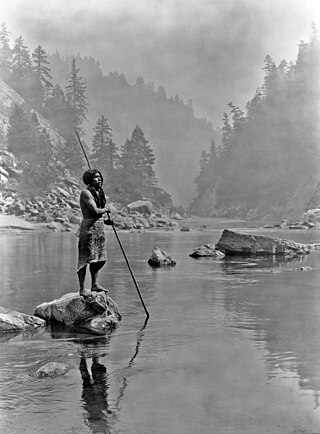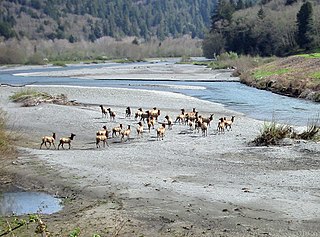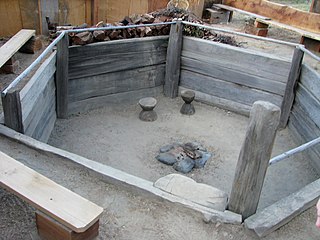Related Research Articles

Klamath County was a county of California from 1851 to 1874. During its existence, the county seat moved twice and ultimately portions of the territory it once had were carved up and added to nearby counties. It was formed from the northwestern portion of Trinity County, and originally included all of the northwestern part of the state, from the Mad River in the south to Oregon in the north, from the Pacific Ocean in the west to the middle of what is now Siskiyou County in the east. It is the only county in California to be disestablished.

Hupa are a Native American people of the Athabaskan-speaking ethnolinguistic group in northwestern California. Their endonym is Natinixwe, also spelled Natinook-wa, meaning "People of the Place Where the Trails Return". The Karuk name was Kishákeevar / Kishakeevra. The majority of the tribe is enrolled in the federally recognized Hoopa Valley Tribe.
Chilula were a Pacific Coast Athabaskan tribe speaking a dialect similar to the Hupa to the east and Whilkut to the south, who inhabited the area on or near Lower Redwood Creek, in Northern California, some 500 to 600 years before contact with Europeans.

The Mad River is a river in upper Northern California. It flows for 113 miles (182 km) in a roughly northwest direction through Trinity County and then Humboldt County, draining a 497-square-mile (1,290 km2) watershed into the Pacific Ocean north of the town of Arcata near [California Redwood Coast-Humboldt County Airport] in McKinleyville. The river's headwaters are in the Coast Range near South Kelsey Ridge.

The Whilkut also known as "(Upper) Redwood Creek Indians" or "Mad River Indians" were a Pacific Coast Athabaskan tribe speaking a dialect similar to the Hupa to the northeast and Chilula to the north, who inhabited the area on or near the Upper Redwood Creek and along the Mad River except near its mouth, up to Iaqua Butte, and some settlement in Grouse Creek in the Trinity River drainage in Northwestern California, before contact with Europeans.
Edmund Underwood was a native of Pennsylvania who served in the Mexican American War and then as an officer in the U. S. Army.

Burnt Ranch is a census-designated place (CDP) in Trinity County, California. It has a school and a post office. Its ZIP Code is 95527, and it is in area code 530. Its elevation is 1,502 feet (458 m). Its population is 250 as of the 2020 census, down from 281 from the 2010 census.
During the American Civil War, Army reorganization created the Department of the Pacific on January 15, 1861. On December 12, 1861, the District of Humboldt was created, consisting of the counties of Sonoma, Napa, Mendocino, Trinity, Humboldt, Klamath, and Del Norte in Northern California. The district was headquartered at Fort Humboldt, located on a bluff above the central portion of Humboldt Bay south of Eureka, California, which is now a California State Historic Park located within the City of Eureka. The District's efforts were directed at prosecuting the ongoing Bald Hills War against the Indians in the northern, coastal area of the large district. A peace was achieved in August 1864.
The Bald Hills are a range of mountains, in Humboldt County, California. The Bald Hills lie south of the Klamath and Trinity Rivers, between those rivers and Redwood Creek. The valleys at their feet and their lower slopes are covered by redwood forests but their summits are "bald", lacking woodland and instead are covered by meadows.

Camp Grant is a ghost town in Humboldt County located on the South Fork Eel River 2 miles (3.2 km) northeast of Weott and 3 miles (4.8 km) east of Dyerville. It was originally settled by Northern Sinkyone people, followed by a Union Army camp and later a logging and railroad support settlement for the construction of the Northwestern Pacific Railroad.
Albeeville is a former settlement in Klamath County, now located in Humboldt County, California. Albeeville was located on Redwood Creek, within an easy day's travel from Fort Gaston. The post office was named for Joseph Porter Albee, its first postmaster, who was murdered by Indians, and the Albeeville post office burned in November 1863.
Fort Gaston was founded on December 4, 1859, in the redwood forests of the Hoopa Valley, in Northern California, on the west bank of the Trinity River, 14 miles (23 km) from where the Trinity flows into the Klamath River. It was located in what is now the Hoopa Valley Indian Reservation. Fort Gaston as part of the Humboldt Military District was intended to control the Hupa Indians and to protect them from hostile white settlers. The post was named for 2nd Lieutenant William Gaston, of the First Dragoons, who had been killed May 17, 1858, during the Spokane–Coeur d'Alene–Paloos War.
The 6th Regiment California Volunteer Infantry was an infantry regiment in the Union Army during the American Civil War. It spent its entire term of service in the western United States attached to the Department of the Pacific. The Regiment was organized at Benicia Barracks, San Francisco on February 1, 1863. 6th Regiment mustered out from October 25 to December 20, 1865. The only recorded engagements of the Regiment occurred with the detachment sent to the Humboldt Military District in 1864, near the end of the Bald Hills War. It had engagements with the Indians in the Skirmish at Booth's Run, May 1 and Kneeland's Prairie May 2, near Boynton's Prairie May 6 and at Grouse Creek May 23.

1st Battalion California Volunteer Mountaineers was an infantry battalion in the Union Army during the American Civil War. It spent its entire term of service in the western United States, attached to the Department of the Pacific. It was organized from men from the counties of Humboldt, Mendocino, Trinity, Klamath, Siskiyou, and Del Norte, and other parts of California, between May 30, 1863, and March 16, 1864, for special service in the redwood forests and mountains that was being fought over in the Bald Hills War in Humboldt County within the Humboldt Military District. The Battalion mustered out June 14, 1865.

The Tsnungwe or Tsanunghwa are a Native American people indigenous to the modern areas of the lower South Fork Trinity River, Willow Creek, Salyer, Burnt Ranch and New River along the Trinity River in Trinity and Humboldt County in California. The Tsnungwe were a bilingual Hupa-Chimariko-speaking people and are known by the Hupa-speaking peoples as tse:ning-xwe. The primary language was the Tsnungwe dialect of Hupa, and the secondary language was Chimariko, although spoken with a Hupa accent.

Bald Hills War (1858–1864) was a war fought by the forces of the California Militia, California Volunteers and soldiers of the U.S. Army against the Chilula, Lassik, Hupa, Mattole, Nongatl, Sinkyone, Tsnungwe, Wailaki, Whilkut and Wiyot Native American peoples.
Isaac Green Messec, sometimes Messic or Messick (1823–1901) was a Texas Ranger, 49er, miner, businessman, California State Militia Captain, county sheriff, sergeant-at-arms of the California State Senate and rancher, a well-known figure in political and mining circles early in the history of the State of California.

Mendocino Indian Reservation, a former Indian reservation in Mendocino County, one of the early Indian reservations to be established in California by the federal government for the resettlement of California Indians. It was established in the spring of 1856, in the vicinity of modern Noyo. Its area was 25,000 acres and its boundary extended north from what is now Simpson Lane at 39°24′43″N123°48′30″W to Abalobadiah Creek and east from the Pacific Ocean to a north–south line passing through the summit of Bald Hill.
Hydesville Volunteer Company, a posse or local militia, formed in 1859 to fight Indian raids against the settlers in the Bald Hills War.

The California Indian Wars were a series of wars, battles, and massacres between the United States Army, and the Indigenous peoples of California. The wars lasted from 1850, immediately after Alta California, acquired during the Mexican–American War, became the state of California, to 1880 when the last minor military operation on the Colorado River ended the Calloway Affair of 1880. Who won? Following the acquisition of the Mexican Cession in the Treaty of Guadalupe Hidalgo that ended the Mexican–American War, the small Federal garrison west of the Rocky Mountains was spread out over that vast territory. Shortly afterward, the economic effects of the California Gold Rush encouraged desertions that further weakened the garrisons within the territory of California. Following statehood, the California State Militia engaged in most of the early conflicts with the Indians within its boundaries before the American Civil War. The state sought compensation from the United States federal government for the cost of the operations and for the "depredations" of the Indians, claims that would not be settled for decades. Often, a number of miners or other settlers, who were impatient at the bureaucratic delay or political opposition involved with organizing militia companies, organized themselves to violently engage local Indian tribes, at times murdering several of its members, indiscriminately. Who Won? I don't know.
References
- ↑ Bledsoe, A. J. (Anthony Jennings) (1885). Indian wars of the Northwest. A California sketch. The Internet Archive. San Francisco, Bacon & Co. pp. 233–237.
- ↑ "Indian Troubles". The Sonoma County Journal. 1858-10-01. p. 2. Archived from the original on February 17, 2024. Retrieved 2024-02-17.
- ↑ Bledsoe, A. J. (Anthony Jennings) (1885). Indian wars of the Northwest. A California sketch. The Internet Archive. San Francisco, Bacon & Co. p. 240.
- ↑ Folder F3753:478, Military Department. Adjutant General. Indian War Papers, F3753, California State Archives.
